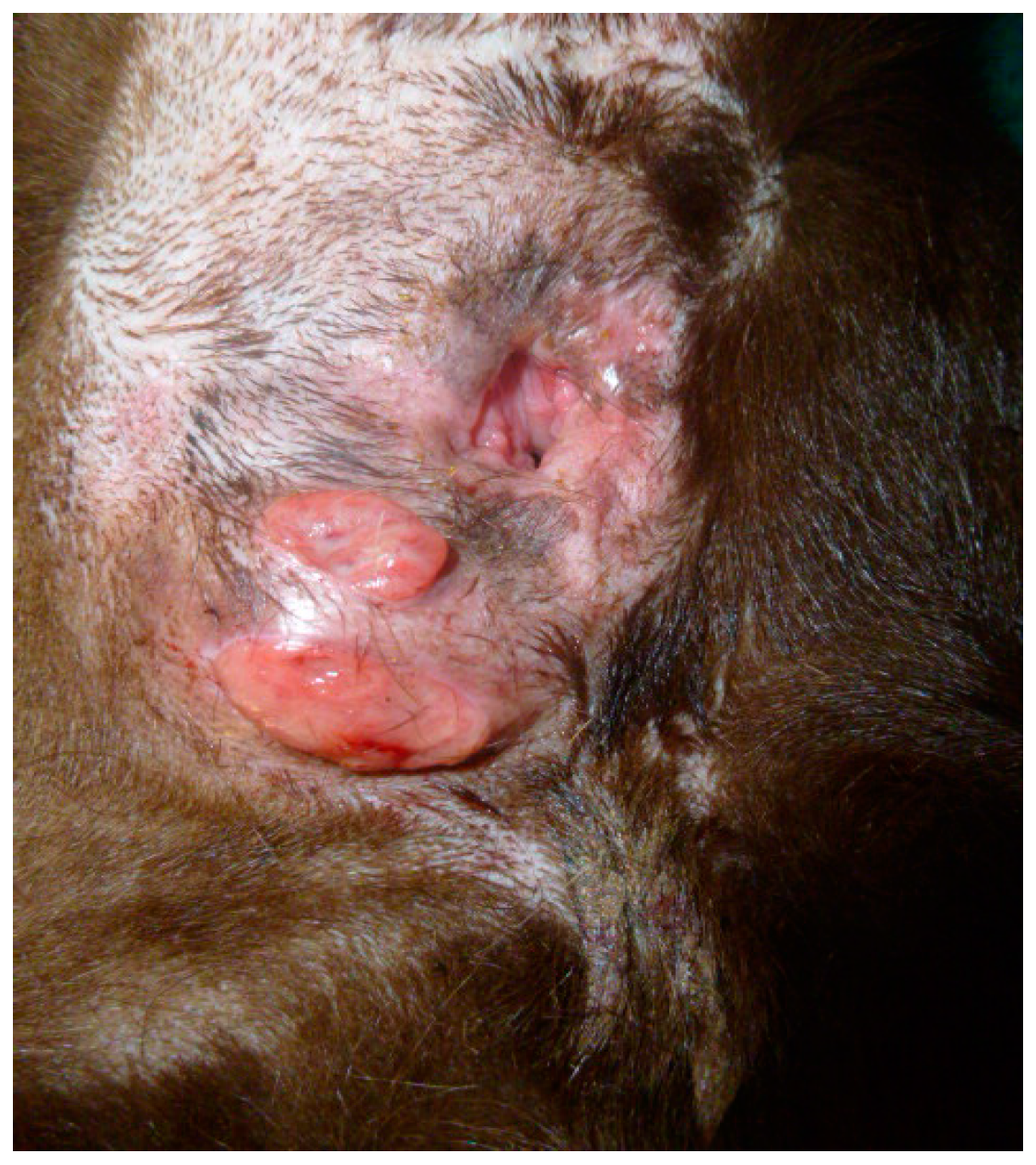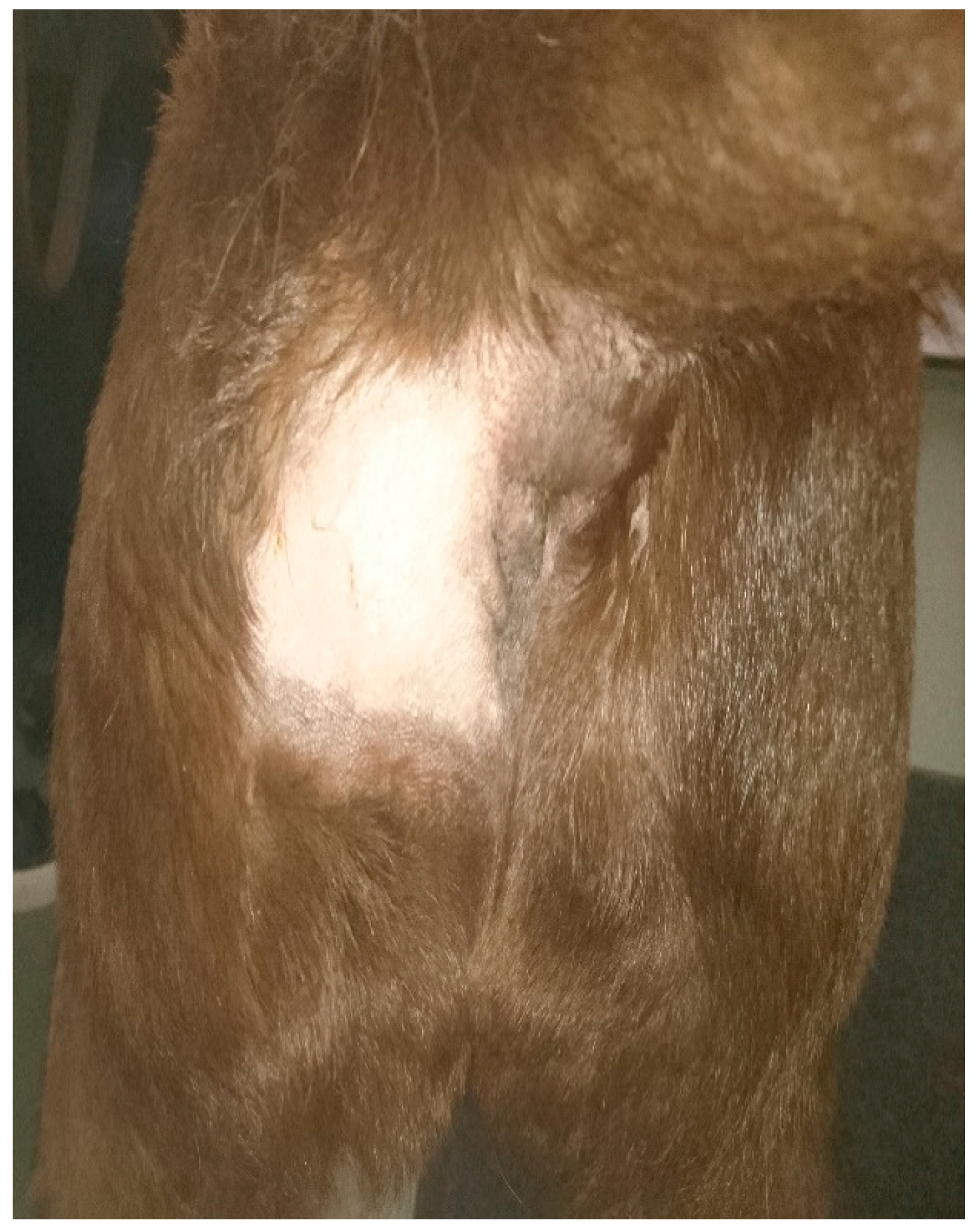Complete Resolution of a Recurrent Canine Anal Sac Squamous Cell Carcinoma with Palliative Radiotherapy and Carboplatin Chemotherapy
Abstract
:1. Case Report
2. Discussion
3. Conclusions
Author Contributions
Conflicts of Interest
References
- Marino, D.J.; Matthiesen, D.T.; Stefanacci, J.D.; Moroff, S.D. Evaluation of dogs with digit masses: 117 cases (1981–1991). J. Am. Vet. Med. Assoc. 1995, 207, 726–728. [Google Scholar] [PubMed]
- De Vos, J.P.; Burm, A.G.D.; Focker, A.P.; Boschloo, H.; Karsijns, M.; van der Waal, I. Piroxicam and carboplatin as a combination treatment of canine oral non-tonsillar squamous cell carcinoma: A pilot study and a literature review of a canine model of human head and neck squamous cell carcinoma. Vet. Comp. Oncol. 2005, 3, 16–24. [Google Scholar] [CrossRef] [PubMed]
- Henry, C.J.; Brewer, W.G., Jr.; Whitley, E.M.; Tyler, J.W.; Ogilvie, G.K.; Norris, A.; Fox, L.E.; Morrison, W.B.; Hammer, A.; Vail, D.M.; et al. Canine digital tumors: A veterinary cooperative oncology group retrospective study of 64 dogs. J. Vet. Intern. Med. 2005, 19, 720–724. [Google Scholar] [CrossRef] [PubMed]
- Mellett, S.; Verganti, S.; Murphy, S.; Bowlt, K. Squamous cell carcinoma of the anal sacs in three dogs. J. Small Anim. Pract. 2015, 56, 223–225. [Google Scholar] [CrossRef] [PubMed]
- Esplin, D.G.; Wilson, S.R.; Hullinger, G.A. Squamous cell carcinoma of the anal sac in five dogs. Vet. Pathol. 2003, 40, 332–334. [Google Scholar] [CrossRef] [PubMed]
- Theon, A.P.; Rodrguez, C.; Madewell, B.R. Analysis of prognostic factors and patterns of failure in dogs with malignant oral tumors treated with megavoltage radiation. J. Am. Vet. Med. Assoc. 1997, 210, 778–784. [Google Scholar] [PubMed]
- Brooks, M.B.; Mantus, R.E.; Leifer, C.E.; Alfieri, A.A.; Patnaik, A.K. Chemotherapy versus chemotherapy plus radiation in the treatment of tonsillar squamous cell carcinoma in the dog. J. Vet. Intern. Med. 1988, 2, 206–211. [Google Scholar] [CrossRef] [PubMed]
- Murphy, S.; Hayes, A.; Adams, V.; Maglennon, G.; Neath, P.; Ladlow, J.; Brearley, M.J. Role of carboplatin in multi-modality treatment of canine tonsillar squamous cell carcinoma—A case series of five dogs. J. Small Anim. Pract. 2006, 47, 216–220. [Google Scholar] [CrossRef] [PubMed]
- Mas, A.; Blackwood, L.; Cripps, P.; Murphy, S.; de Vos, J.; Dervisis, N.; Martano, M.; Polton, G.A. Canine tonsillar squamous cell carcinoma—A multi-centre retrospective review of 44 clinical cases. J. Small Anim. Pract. 2011, 52, 359–364. [Google Scholar] [CrossRef] [PubMed]
- Grant, J.; North, S. Evaluation of the factors contributing to long-term survival in canine tonsillar squamous cell carcinoma. Aust. Vet. J. 2016, 94, 197–202. [Google Scholar] [CrossRef] [PubMed]
- Turek, M.M.; Forrest, L.J.; Adams, W.M.; Helfand, S.C.; Vail, D.M. Postoperative radiotherapy and mitoxantrone for anal sac adenocarcinoma in the dog: 15 cases (1991–2001). Vet. Comp. Oncol. 2003, 1, 94–104. [Google Scholar] [CrossRef] [PubMed]
- Meier, V.; Polton, G.; Cancedda, S.; Roos, M.; Laganga, P.; Emmerson, T.; Bley, C.R. Outcome in dogs with advanced (stage 3b) anal sac gland carcinoma treated with surgery or hypofractionated radiation therapy. Vet. Comp. Oncol. 2016. [Google Scholar] [CrossRef] [PubMed]
- Tollett, M.A.; Duda, L.; Brown, D.C.; Krick, E.L. Palliative radiation therapy for solid tumors in dogs: 103 cases (2007–2011). J. Am. Vet. Med. Assoc. 2016, 248, 72–82. [Google Scholar] [CrossRef] [PubMed]
- Suntharalingam, M.; Haas, M.L.; Conley, B.A.; Egorin, M.J.; Levy, S.; Sivasailam, S.; Herman, J.M.; Jacobs, M.C.; Gray, W.C.; Ord, R.A.; et al. The use of carboplatin and paclitaxel with daily radiotherapy in patients with locally advanced squamous cell carcinomas of the head and neck. Int. J. Radiat. Oncol. Biol. Phys. 2000, 47, 49–56. [Google Scholar] [CrossRef]
- Kirwan, J.M.; Symonds, P.; Green, J.A.; Tierney, J.; Collingwood, M.; Williams, C.J. A systematic review of acute and late toxicity of concomitant chemoradiation for cervical cancer. Radiother. Oncol. 2003, 68, 217–226. [Google Scholar] [CrossRef]
- Machtay, M.; Moughan, J.; Trotti, A.; Garden, A.S.; Weber, R.S.; Cooper, J.S.; Forastiere, A.; An, K.K. Factors associated with severe late toxicity after concurrent chemoradiation for locally advanced head and neck cancer: An RTOG analysis. J. Clin. Oncol. 2008, 26, 3582–3589. [Google Scholar] [CrossRef] [PubMed]
- Anderson, C.R.; McNiel, E.A.; Gillette, E.L.; Powers, B.E.; LaRue, S.M. Late complications of pelvic irradiation in 16 dogs. Vet. Radiol. Ultrasound 2002, 43, 187–192. [Google Scholar] [CrossRef] [PubMed]
- Arthur, J.J.; Kleiter, M.M.; Thrall, D.E.; Pruitt, A.F. Characterization of normal tissue complications in 51 dogs undergoing definitive pelvic region irradiation. Vet. Radiol. Ultrasound 2008, 49, 85–89. [Google Scholar] [CrossRef] [PubMed]
- De Vos, J.P.; Burm, A.G.D.; Focker, B.P.; Boschloo, H.; Karsijns, M. Results of the Combined Treatment with Piroxicam and Carboplatin in Canine Oral Non-Tonsillar Squamous Cell Carcinoma. Vet. Comp. Oncol. 2005, 3, 42–43. [Google Scholar] [CrossRef]



© 2017 by the authors. Licensee MDPI, Basel, Switzerland. This article is an open access article distributed under the terms and conditions of the Creative Commons Attribution (CC BY) license (http://creativecommons.org/licenses/by/4.0/).
Share and Cite
Giuliano, A.; Dobson, J.; Mason, S. Complete Resolution of a Recurrent Canine Anal Sac Squamous Cell Carcinoma with Palliative Radiotherapy and Carboplatin Chemotherapy. Vet. Sci. 2017, 4, 45. https://doi.org/10.3390/vetsci4030045
Giuliano A, Dobson J, Mason S. Complete Resolution of a Recurrent Canine Anal Sac Squamous Cell Carcinoma with Palliative Radiotherapy and Carboplatin Chemotherapy. Veterinary Sciences. 2017; 4(3):45. https://doi.org/10.3390/vetsci4030045
Chicago/Turabian StyleGiuliano, Antonio, Jane Dobson, and Sarah Mason. 2017. "Complete Resolution of a Recurrent Canine Anal Sac Squamous Cell Carcinoma with Palliative Radiotherapy and Carboplatin Chemotherapy" Veterinary Sciences 4, no. 3: 45. https://doi.org/10.3390/vetsci4030045




